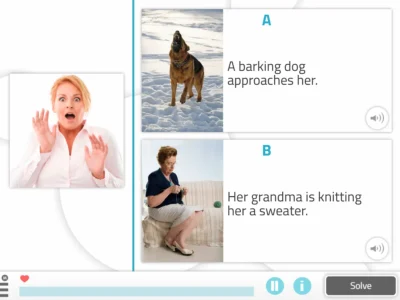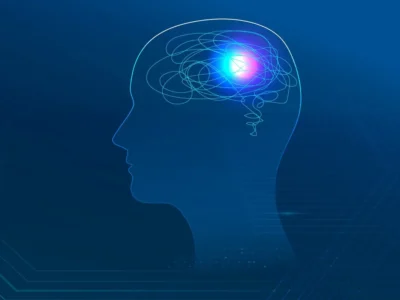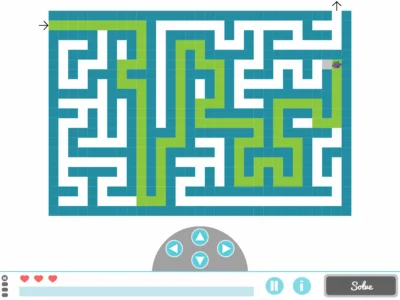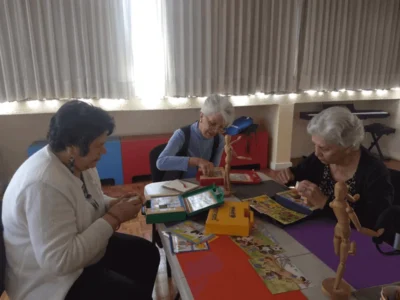Speech therapist Paola González Lázaro explains how remote speech therapy supports aphasia rehabilitation.
Introduction
Remote speech therapy has become an effective alternative within aphasia rehabilitation. Recent studies on the effectiveness of teletherapy in aphasia show that this approach can be as successful as in-person interventions.
Key concepts: aphasia, language and speech therapy
What is aphasia?
The aphasia is a language and communication disorder that occurs as a result of a brain injury. It can affect spoken expression, auditory comprehension, reading and writing. The severity and the characteristics of the different types of aphasia depend on where it is located and how extensive the brain damage that caused it is. The main etiology is vascular in origin. Other common causes are trauma, tumors and brain infections.
What is language?
Language is much more than a form of communication; it is also a tool of thought and cognition, and it is the fundamental means to interact with others.
When a person has aphasia, all areas of their life are affected: family, social and partner relationships, work performance, financial aspects, self-esteem and self-image. Hence it is so important to have access to a language rehabilitation program.
What is speech therapy?
Speech therapy is central to the recovery process of patients, even years after the injury. Therapy favors brain plasticity and allows finding alternative communication pathways. Its main objective is to restore functional communication in order to achieve patients’ readjustment (González Lázaro y González Ortuño, 2024).
However, in many countries, including Spanish-speaking ones, there is a limited number of specialists with the training and experience necessary to work with people with aphasia, especially far from capitals and major cities. In this context, remote therapy offers the possibility that more patients can receive therapeutic support, which promotes equity in access to treatment.
What is remote speech therapy for aphasia?
Remote therapy, also called teletherapy, takes place via video calls using a platform that allows the patient and the specialist to connect in real time. It is a practical application of technology that has gained popularity in recent years in the field of neuropsychological rehabilitation, including aphasia.
There are different platforms for video calls, both free and paid. Among the most popular are Zoom, Teams and Google Meet. An encrypted system should be chosen to ensure the security and confidentiality of sessions. Due to their ease of use, in most cases, even those with limited experience with technology can learn to use the platforms and benefit from teletherapy.
Otherwise, it is suggested that a family member or caregiver help the patient start the session and resolve any technical problems. Their support may also be necessary to carry out some of the therapy activities, especially when the patient presents moderate to severe language impairments.
Regarding technological requirements, both the specialist and the patient must have a stable high-speed internet connection that allows audio and video to be transmitted without interruptions. It is recommended to use a computer or a tablet with a large screen so that the patient can easily distinguish the gestures and the specialist’s facial expressions, as well as the exercises they share.

Subscribe
to our
Newsletter
Advantages and limitations of online speech therapy
Advantages of teletherapy for aphasia
Teletherapy is a convenient option for people with reduced mobility, for example, patients with hemiplegia or hemiparesis. These impairments are a very common comorbidity in anterior aphasias, since the motor area of the brain is adjacent to the area responsible for language expression.
Remote therapy is also convenient for those patients who would depend on someone to accompany them to in-person sessions. From an economic point of view, taking therapy from home allows the patient to save the cost (and time) of travel. In addition, it facilitates the participation of family members and caregivers.
Limitations of teletherapy for aphasia
Regarding limitations, teletherapy is usually not the best option to work with people with global aphasia or severe impairments in comprehension or articulation, since the types of activities that are most useful in these cases are difficult to carry out remotely.
On the other hand, rehabilitation of writing (agraphia) can be a challenge; it is not easy to observe what patients write and support them to correct the errors they make.
| Summary of the advantages of teletherapy for aphasia | Summary of the limitations of teletherapy for aphasia |
|---|---|
| 1. Convenient option for people with reduced mobility and for those who rely on someone else to accompany them to their in-person sessions. | 1. In a minority of cases, it is not the best option to work with people with global aphasia or severe impairments in comprehension and articulation. |
| 2. Time and cost savings. | 2. In a minority of cases, rehabilitation of agraphia can be a challenge. |
| 3. Facilitates the participation of both family members and caregivers. |
It should be emphasized that the mentioned limitations correspond to a minority; the vast majority of patients with aphasia can successfully participate in remote sessions by making the necessary adaptations for each case.
Effectiveness of teletherapy in aphasia rehabilitation
Several comparative studies (Carr et al., 2022; Cetinkaya et al., 2023; Weidner y Lowman, 2020) conclude that language therapies for people with aphasia delivered remotely have effectiveness comparable to in-person ones.
They can be successfully used to address specific aspects of language, such as verbal fluency, naming and auditory comprehension. Improvements in functional communication in everyday situations have also been found even in chronic patients (Macoir et al., 2017). Remote treatment can make patients’ conversations more efficient by acquiring alternative strategies to convey what they want to express.
Group teletherapy for people with aphasia has been shown to have multiple benefits (Pitt et al., 2019). A very significant aspect is that working in a group enables patients’ social interaction, creates an environment of empathy and helps them adapt to the changes they face as a consequence of aphasia. This has a positive impact on their mood and quality of life. Remote sessions allow people from different cities and even different countries to meet, which enriches the conversations. Additionally, it has been observed that those who participate in the sessions improve their overall communication ability and linguistic aspects such as naming and reading.
Regarding the assessment process, there is evidence showing that remote therapy is a valid method to evaluate patients’ language, with inter-rater reliability comparable to that obtained in in-person assessments (Dekhtyar et al., 2020; Weidner y Lowman, 2020).
Finally, there are studies that suggest that patients who have received remote therapy show a high level of satisfaction (Jacobs et al., 2021), which is closely related to the progress they make. It has also been observed that patients tend to be consistent and committed to the treatment.
Digital neurorehabilitation platforms for aphasia rehabilitation
It is possible to easily incorporate the use of technological resources into remote sessions, including NeuronUP.
They allow content to be worked on in an attractive, systematic and organized way. Activities can be carried out directly with patients, or be a resource for them to practice at home between sessions, being an additional way to stimulate language and progress in rehabilitation. In addition, activities can be adapted to the patient’s performance level and include the option to repeat exercises as many times as necessary, which facilitates the automation of strategies. An additional advantage is having an objective follow-up of progress.
Digital rehabilitation provides a sense of autonomy and independence. Patients appear motivated and highly satisfied when using programs and applications (Repetto et al., 2020). This favors commitment to treatment and therefore maximizes the chances of observing improvements.
Specifically in the case of language rehabilitation, several studies conclude that computer-assisted therapy is an efficient support in the treatment of people with aphasia (Repetto et al., 2020; Zheng et al., 2015). Those who have followed this type of therapy, including patients in the chronic stage, have improved language skills such as verbal fluency, auditory comprehension, naming and reading (Braley et al., 2021).
Regarding anomia rehabilitation (difficulty finding words), a generalization effect has been observed (Lavoie et al., 2017). This means that the improvement in naming ability is notable, even for words that are not directly trained. It is an important finding since all people with aphasia present anomia to a greater or lesser extent.
It is important to emphasize that ideally a specialist in aphasia rehabilitation should guide the selection of resources, so that the activities are appropriate for the patient’s language level and help them achieve the goals established in therapy.
Conclusions on language telerehabilitation
Remote language rehabilitation has the potential to make language rehabilitation accessible to more people, including those who would have difficulty attending in-person therapy, or those who live in places where there are no specialists experienced in treating aphasia. As access to mobile devices and computers becomes more widespread and evidence accumulates in favor of this therapeutic option, it is expected that the use of teletherapy will increase as an efficient alternative in the treatment of people with aphasia.
Language rehabilitation must evolve alongside technological advances, so that patients benefit from the opportunities that our era offers.
Bibliografía
- Braley, M., Pierce, J. S., Saxena, S., De Oliveira, E., Taraboanta, L., Anantha, V., Lakhan, S. E. y Kiran, S. (2021). A virtual, randomized, control trial of a digital therapeutic for speech, language, and cognitive intervention in post-stroke persons with aphasia. Frontiers in Neurology, 12(12), 626780.
- Carr, P., Moser, D., Williamson, S., Robinson, G. y Kintz, S. (2022). Improving functional communication outcomes in post-stroke aphasia via telepractice: An alternative service delivery model for underserved populations. Interational Journal of Telerehabilitation, 14(2),1-20.
- Cetinkaya, B., Twomey, K., Bullard, B., EL Kouaissi S. y Conroy, P. (2023). Telerehabilitation of aphasia: A systematic review of the literature. Aphasiology, 38(7), 1271-1302.
- Dekhtyar, M., Braun, E. J., Billot, A., Foo, L. y Kiran, S. (2020). Videoconference administration of the Western Aphasia Battery-Revised: Feasibility and validity. American Journal of Speech-Language Pathology, 29(2), 673-687.
- González Lázaro, P. y González Ortuño, B. (2024). Afasia. De la teoría a la práctica. 2da. edición. México: Editorial Médica Panamericana.
- Jacobs, M., Briley, P. M., Fang, X. y Ellis, C. (2021). Telepractice treatment for aphasia: Association between clinical outcomes and client satisfaction. Telemedicine Reports, 2(1), 118-124.
- Lavoie, M., Macoir, J. y Bier, N. (2017). Effectiveness of technologies in the treatment of post-stroke anomia: A systematic review. Journal of Communication Disorders, 65, 43-53.
- Macoir, J., Sauvageau, V. M., Boissy, P., Tousignant, M. y Tousignant, M. (2017). In-home synchronous telespeech therapy to improve functional communication in chronic poststroke aphasia: Results from a quasi-experimental study. Telemedicine and e-Health, 23(8), 630-639.
- Pitt, R., Theodoros, D., Hill, A. J. y Russell, T. (2019). The impact of the telerehabilitation group aphasia intervention and networking programme on communication, participation, and quality of life in people with aphasia. International Journal of Speech-Langugage Pathology, 21(5), 513-523.
- Repetto, C., Paolillo, M. P., Tuena, C., Bellinzona, F. y Riva, G. (2020). Innovative technology-based interventions in aphasia rehabilitation: A systematic review. Aphasiology, 35(1), 1-24.
- Weidner, K. y Lowman, J. (2020). Telepractice for adult speech-language pathology services: A systematic review. Perspectives ASHA Special Interests Groups, 5, 326-338.
- Zheng, C., Lynch, L. y Taylor, N. (2015). Effect of computer therapy in aphasia: A systematic review. Aphasiology, 30(2-3), 211-44.
Frequently asked questions about remote speech therapy for aphasia
1. What is remote speech therapy for aphasia rehabilitation?
Remote speech therapy, or teletherapy, delivers aphasia rehabilitation via secure videoconferencing. Therapist and patient work in real time to restore functional communication. It extends specialist access, complements neuropsychological rehabilitation, and can include individual or group sessions tailored to language goals.
2. Is teletherapy as effective as in-person aphasia therapy?
Comparative studies report outcomes comparable to in-person therapy. Teletherapy can improve verbal fluency, naming, auditory comprehension and functional communication, including in chronic post-stroke aphasia. Group teletherapy also supports participation, mood, and quality of life through peer interaction.
3. What are technology requirements for online aphasia therapy sessions?
A stable high-speed internet connection, a computer or large-screen tablet, camera, and an encrypted videoconferencing platform are recommended. Clear audio-video aids comprehension of facial cues and materials. A caregiver may help start sessions and troubleshoot when language impairments are moderate to severe.
4. Who benefits from aphasia teletherapy in Spanish-speaking countries?
Teletherapy benefits people with reduced mobility or limited local specialists, improving equity of access. It saves travel time and costs, and facilitates caregiver involvement. It may be less suitable for global aphasia or severe comprehension/articulation impairments; these cases require careful adaptation.
5. Can language assessment be reliably conducted through telepractice?
Yes. Remote language assessment shows feasibility with inter-rater reliability comparable to in-person evaluations when conducted via videoconference. Validity depends on appropriate tools, clear audio-video quality, and standardized procedures administered by trained clinicians.
6. How do digital platforms support aphasia rehabilitation and practice?
Digital neurorehabilitation platforms organize adaptable, repeatable language activities for use during sessions and home practice, with objective progress tracking. Evidence suggests benefits for naming, reading, auditory comprehension, fluency, and generalization in anomia. A specialist should guide resource selection; this is not medical advice.
If you liked this article about the remote speech therapy in aphasia rehabilitation, you will surely be interested in these NeuronUP articles:
“This article has been translated. Link to the original article in Spanish:”
Terapia de lenguaje a distancia en la rehabilitación de la afasia







Leave a Reply